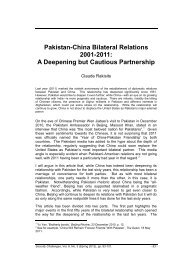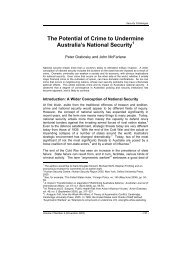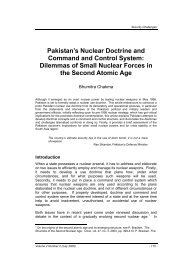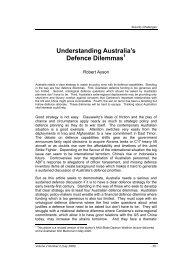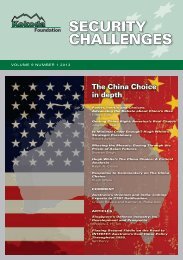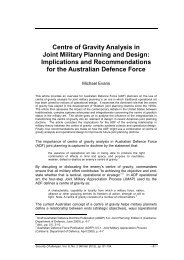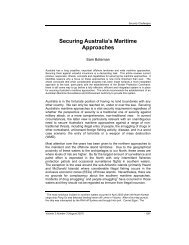The Transformation of Triad - Security Challenges
The Transformation of Triad - Security Challenges
The Transformation of Triad - Security Challenges
Create successful ePaper yourself
Turn your PDF publications into a flip-book with our unique Google optimized e-Paper software.
Roderic Broadhurst and Lee King Wa<br />
<strong>Triad</strong>s and Globalisation<br />
<strong>Triad</strong>s have been regarded by some authorities as participating in a<br />
worldwide crime network that uses connections among overseas Chinese to<br />
undertake transnational crime such as drug and human trafficking. 34 Fears 35<br />
that HK triads would re-establish abroad en masse with the return <strong>of</strong><br />
Chinese sovereignty in 1997 appear not to have materialised despite<br />
alarmist predictions. 36 However, significant triad-related capital and capacity<br />
where thought to have reached among others Toronto, Vancouver, Sydney<br />
and Los Angeles that enabled such groups to hedge risk and transfer<br />
resources. 37 Market reforms initially in Shenzhen SEZ in the 1980s and later<br />
elsewhere in China provided more attractive opportunities and lower costs<br />
for criminal enterprise. 38<br />
Chin and Zhang 39 have argued that triads have been in decline among the<br />
Chinese diaspora and are sceptical about the existence <strong>of</strong> triad global<br />
networks. 40 <strong>The</strong>y argue, in the case <strong>of</strong> human trafficking, this is because <strong>of</strong><br />
a ‘structural deficiency’ that arises from a strong common culture and<br />
tradition that provides discipline in a local context but also limits their<br />
capacity to develop strong transnational networks. <strong>The</strong>y recently noted the<br />
growth <strong>of</strong> Chinese crime groups in both local and transnational illicit<br />
See A. Woodiwiss, ‘Double Cross: States, Corporations, and the Global Reach <strong>of</strong> Organized<br />
Crime’, International Criminal Justice Review, vol. 17 (2007), pp. 45-51.<br />
34 B. Lintner, Blood Brothers: <strong>The</strong> Criminal Underworld <strong>of</strong> Asia (New York: Palgrave Macmillan,<br />
2003); M. Booth, <strong>The</strong> Dragon Syndicates: <strong>The</strong> Global Phenomenon <strong>of</strong> the <strong>Triad</strong>s (New York:<br />
Carroll and Graf, 1999).<br />
35 Similar fears about the Italian mafia were expressed following the ‘Schengen’ agreement that<br />
provided unrestricted travel between the European signatories; see van Duyne and Vander<br />
Beken, ‘<strong>The</strong> Incantations <strong>of</strong> the EU Organized Crime Policy Making’, p. 269.<br />
36 For example J. Dombrink and H. L. Song, ‘Hong Kong after 1997: Transnational Organized<br />
Crime in a Shrinking World’, Journal <strong>of</strong> Contemporary Criminal Justice, vol. 12 (1996), pp. 329-<br />
39. <strong>The</strong> contrary position was <strong>of</strong>fered in an Australian assessment: see Parliament <strong>of</strong> the<br />
Commonwealth <strong>of</strong> Australia, ‘Asian Organized Crime in Australia: A Discussion Paper by the<br />
Parliamentary Joint Committee on the National Crime Authority’, February 1995,<br />
[Accessed 11 May 2009].<br />
37 Personal communication, Australian Crime Commission (ACC), 7 July 2009.<br />
38 C. S. Wren, ‘China Attracts Hong Kong’s Money, and Gangsters’, New York Times, 31 March<br />
1983, p. A2; Carl Goldstein, ‘China: Two Faces <strong>of</strong> Reform’, Far Eastern Economic Review, vol.<br />
156, no. 14 (8 April 1993), p. 15; I. Dobinson, ‘Pinning a Tail on the Dragon: <strong>The</strong> Chinese and<br />
the International Heroin Trade’, Crime and Delinquency, vol. 39, no. 3 (1993), pp. 373-84;<br />
Commonwealth <strong>of</strong> Australia, ‘Asian Organized Crime in Australia: A Discussion Paper by the<br />
Parliamentary Joint Committee on the National Crime Authority’; Laidler, Hodson and Traver,<br />
<strong>The</strong> Hong Kong Drug Market: A Report for the UNICRI; Williams and Godson, ‘Anticipating<br />
organised and transnational crime’.<br />
39 K. L. Chin and S. Zhang, ‘<strong>The</strong> Declining Significance <strong>of</strong> <strong>Triad</strong> Societies in Transnational Illegal<br />
Activities: A Structural Deficiency Perspective’, <strong>The</strong> British Journal <strong>of</strong> Criminology, vol. 43<br />
(2003), pp. 469-88; see also Chu, <strong>The</strong> <strong>Triad</strong>s as Business.<br />
40 Specifically in relation to the drug trade see K. L. Chin, <strong>The</strong> Golden Triangle: Inside Southeast<br />
Asia’s Drug Trade (Ithaca: Cornell University Press, 2009), pp. 230-4.<br />
- 6 - <strong>Security</strong> <strong>Challenges</strong>



